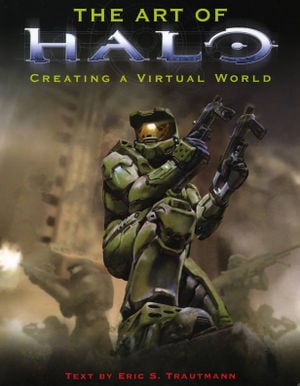The Art of Halo: Creating a Virtual World
From Halopedia, the Halo wiki
| The Art of Halo: Creating a Virtual World | |
|---|---|

| |
|
Author(s): |
|
|
Publisher: |
|
|
Publication date: |
|
|
Media type: |
Print (paperback)[1] |
|
Pages: |
176 pages[1] |
|
Dimensions: |
8.4 x 0.4 x 10.8 inches[1] |
|
Weight: |
1.7 pounds (0.77 kg)[1] |
|
ISBN: |
|
The Art of Halo: Creating a Virtual World is a collection of concept art used during the production of Halo: Combat Evolved and Halo 2, with commentary by Eric S. Trautmann. The book includes a foreword by Jason Jones and a preface by Marcus R. Lehto.
A successor to The Art of Halo, titled Halo: The Great Journey: The Art of Building Worlds, was released on October 18, 2011.[2]
Official summary[edit]
| “ | When Halo hit the shelves with the launch of the Xbox in 2001, it was an immediate sensation. This action-packed science fiction—military combat game, set on a distant, war-torn, artificial planet, became an instant triumph with gamers – and scored numerous awards for its innovations, irresistibility, and sheer thrills. The Art of Halo is a showcase of its stunning visual style, a fascinating guided tour through the making of the phenomenon–from bright idea to brilliant result–and a testament to the creativity of the artists at Bungie Studios.
It’s all here – the story behind the sensation that GamePro declares “above and beyond what console gamers have come to expect” – in one virtuoso volume![1] |
” |
Content review[edit]
The Art of Halo begins with a foreword by Jason Jones and a preface by Marcus Lehto. It then introduces "Halo's architects" (Bungie Studios), before chapters on character design, environments, weapons and gear and vehicles. The final chapter, "The Art of Game Design", is a selection of promotional artwork and posters, game engine screenshots, multiplayer map sketches, cinematic storyboards, musical scores, animations and dialogue scripts from Halo: Combat Evolved and Halo 2.
The majority of the book focuses on the development of the major aspects of Halo: Combat Evolved and Halo 2, from the Weapons, the games environments and the Character designs. There are many early sketches and concept art for these things, much of it by Shi Kai Wang and the Bungie art team. Certain sections show the influence of earlier Bungie games on Halo's design. One section shows a timeline of Bungie's history. The ideas are shown as they evolved, from a series of sketches to storyboards and their amazing animation. Finally, some screenshots are included to show how the ideas were eventually incorporated into the Halo games.
There are also many explanations for the processes and the development. For example, the role of Grunt Ultras. They also explain what the intentions were for many of the ideas and how they changed over time.
Trivia[edit]
- There are many errors in this book, such as a caption pointing at a Plasma Grenade, but pointing it out as an Assault Bomb. However, the Assault Bomb is also present on the page. Another mistake consisted in calling the Prophet of Mercy the Prophet of Truth.
- While the book shows the ranks of certain species within the Covenant the Elites' section is missing the ranks of Ultra and Councilor.
- This book shows the Easter egg on the Assault Bomb, where it has writing on it.
- The Sangheili Zealot shown on the Elite ranks has black as its secondary color, although the secondary color for Zealots in-game is brown.
- The level "Assault on the Control Room" is mistakenly titled "Attack on the Two Control Rooms".
Sources[edit]
| ||||||||||||||||||||